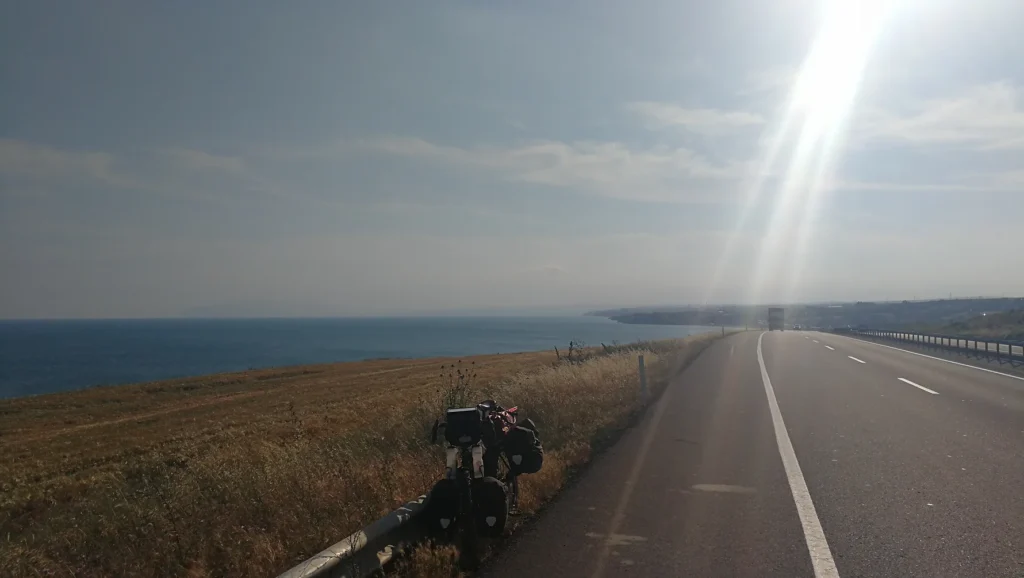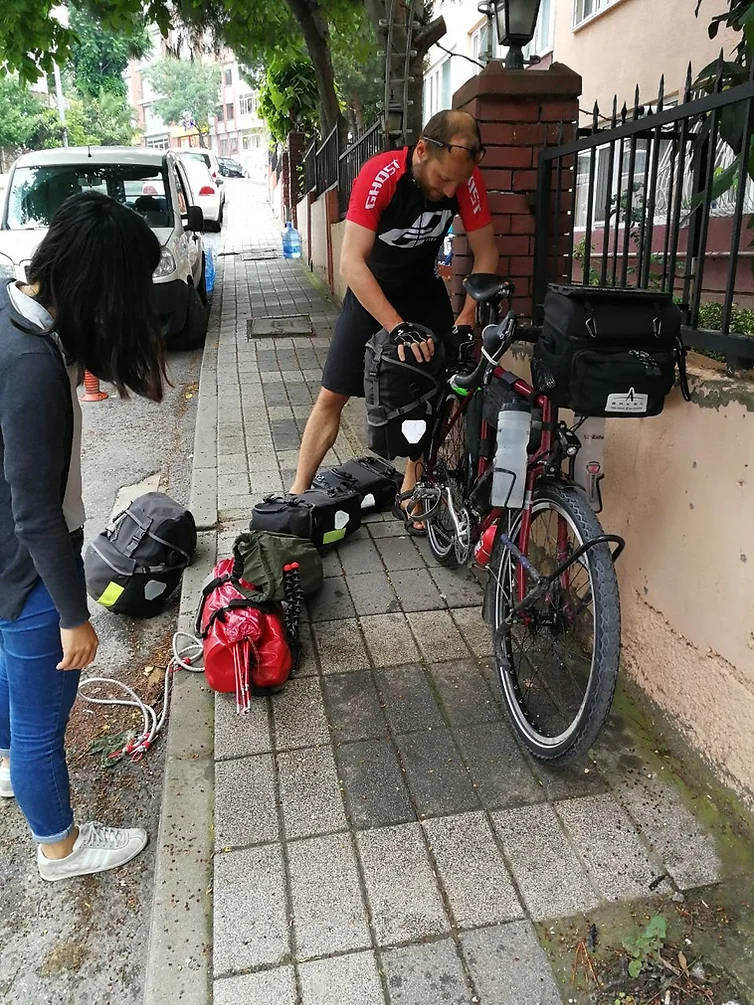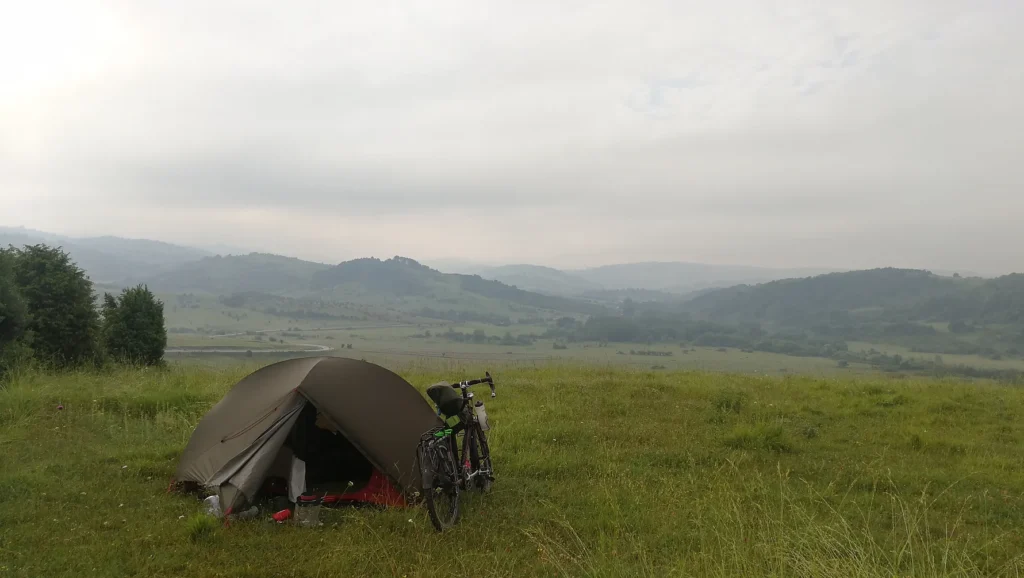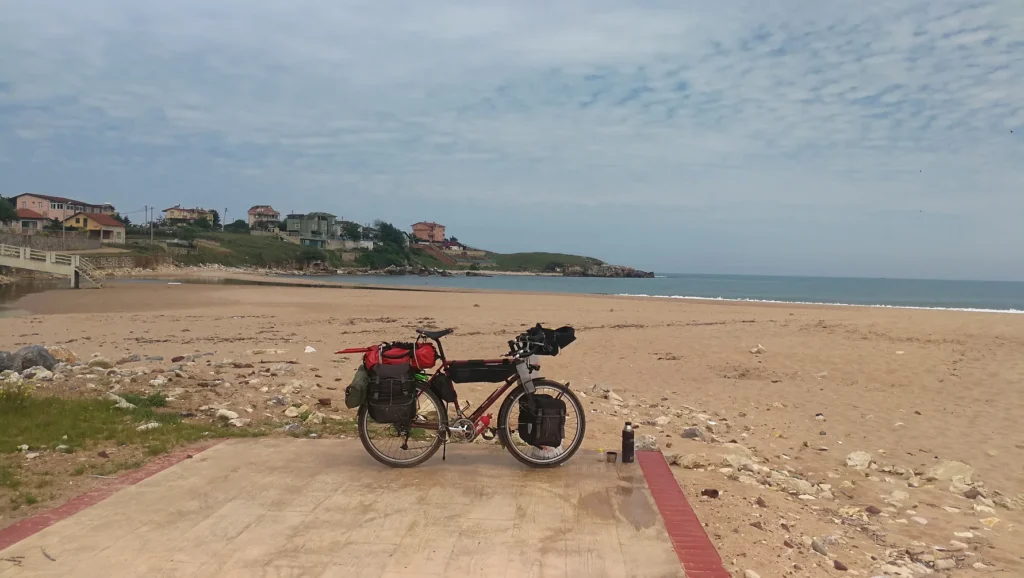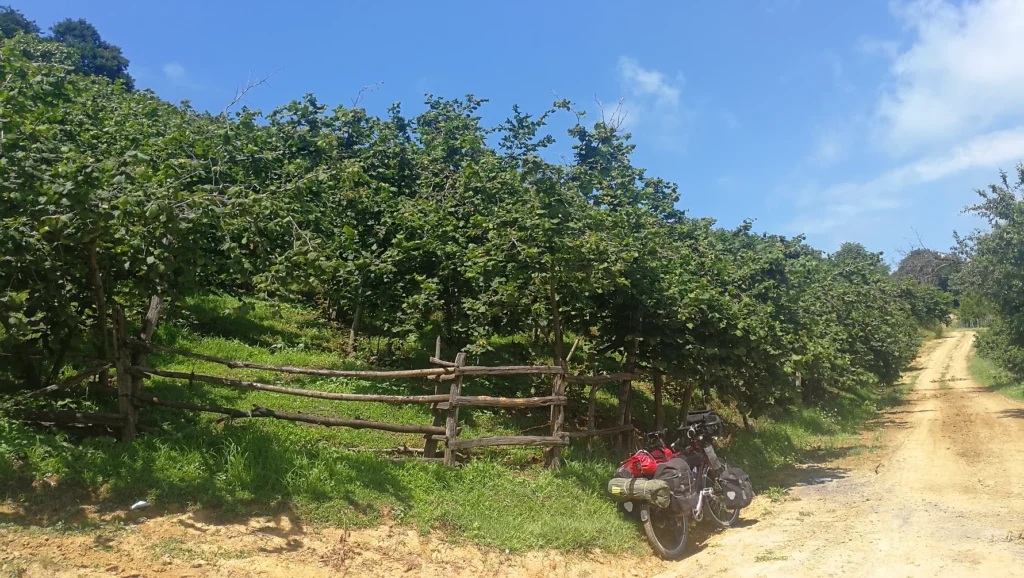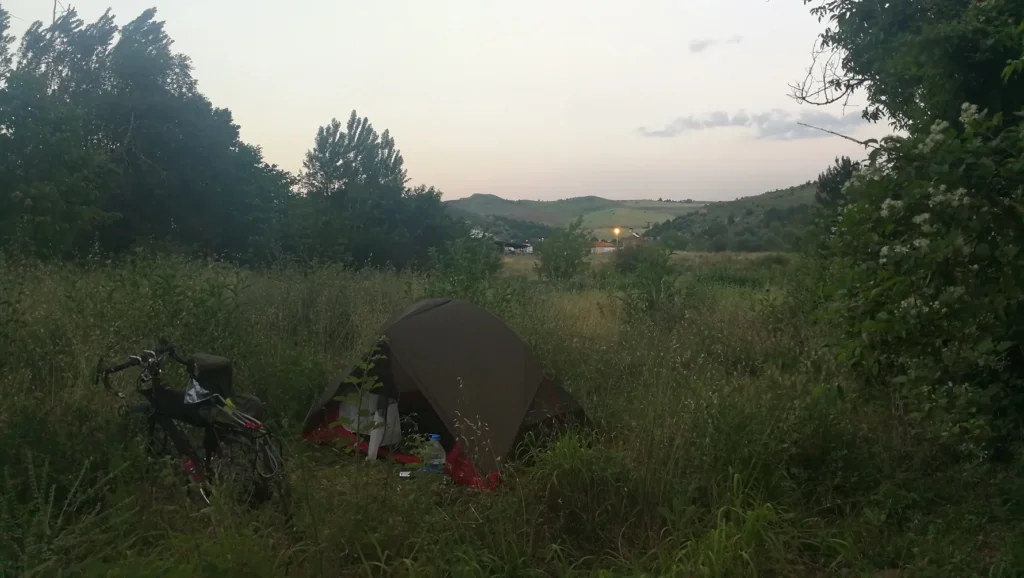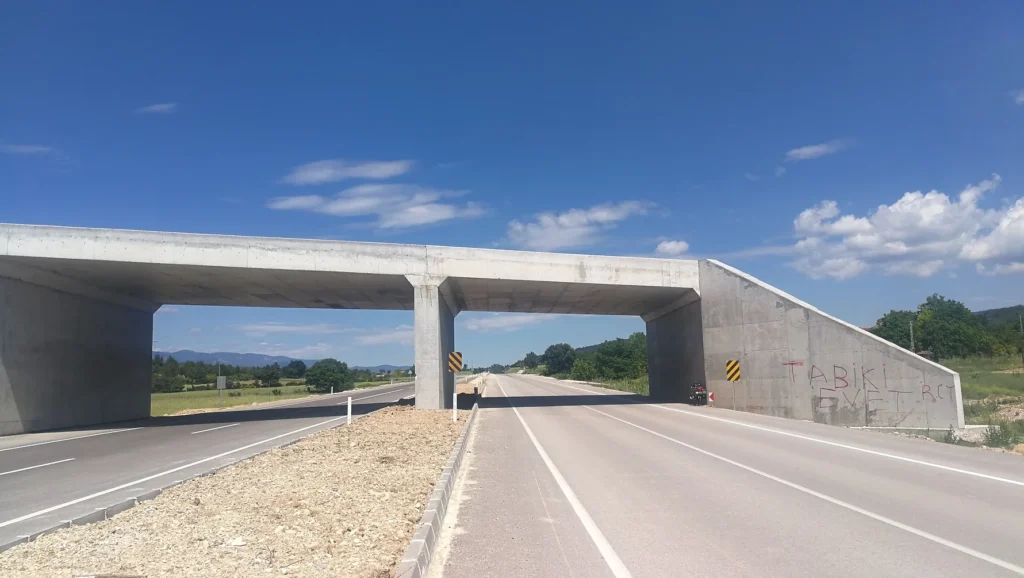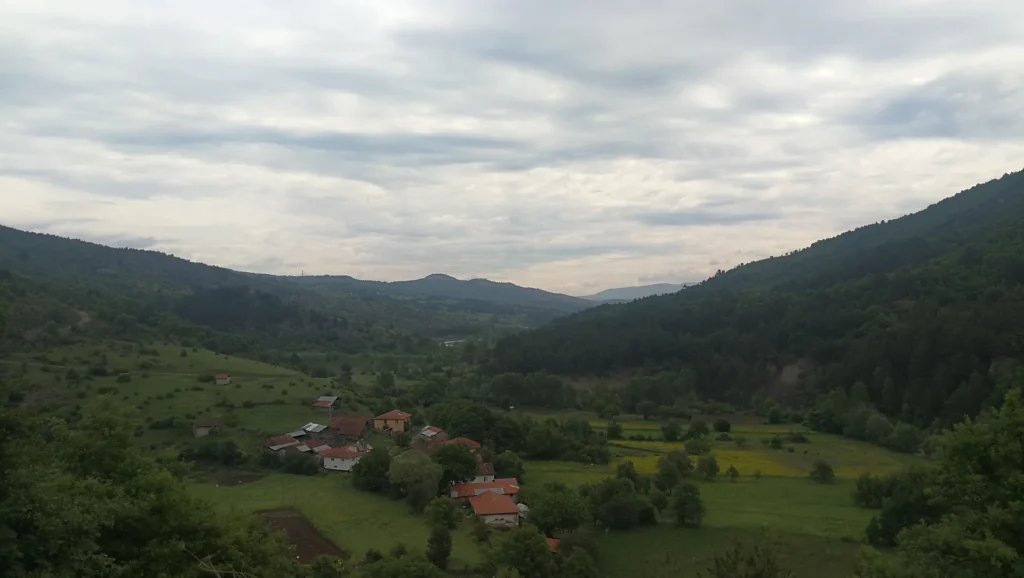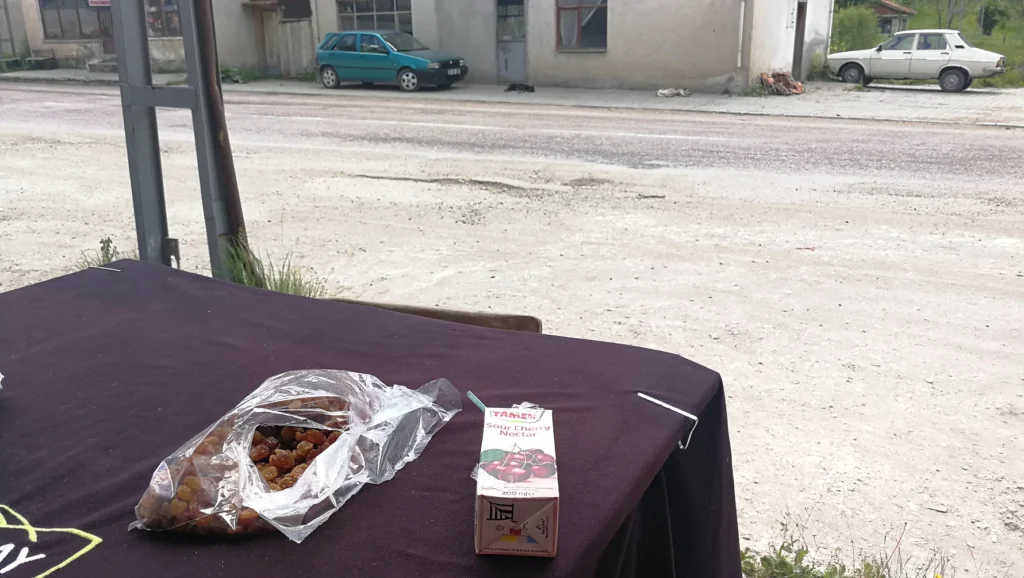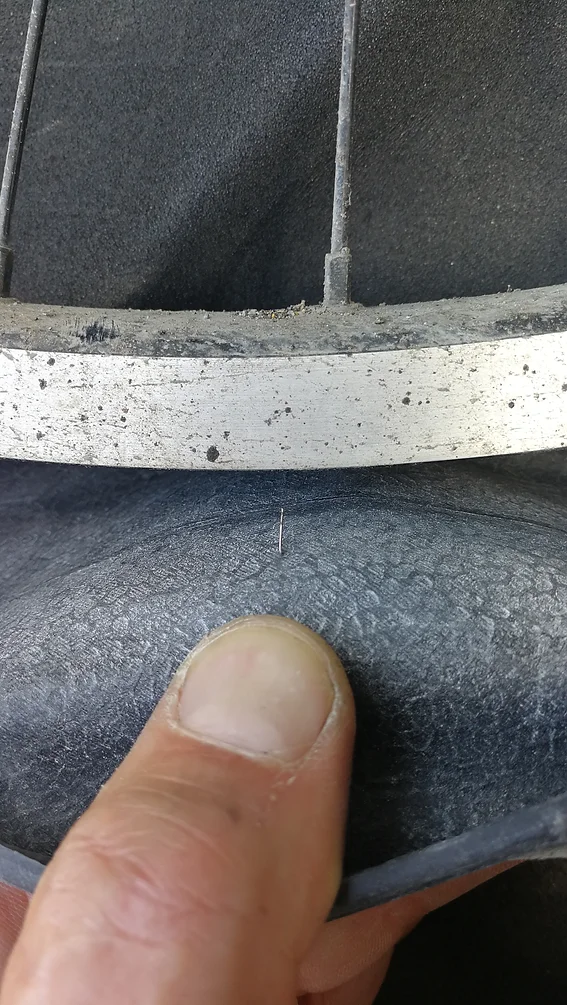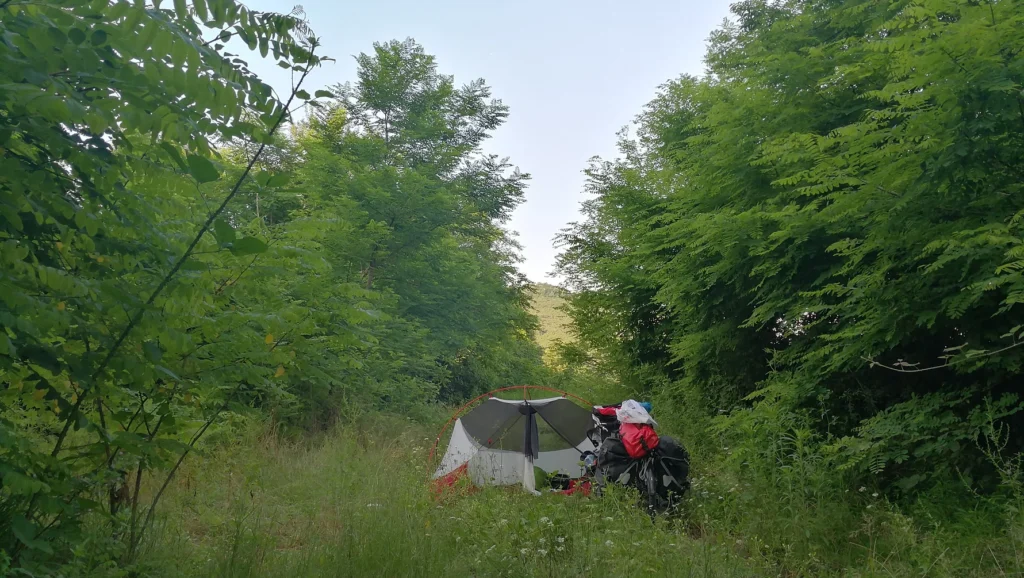Turkey — Yourself
Merhaba Türkiye! I felt ready to cycle through this large country – at least 1,400 kilometer lay ahead until the border with Georgia on the shortest route. And I felt excited to meet the locals.
For many years before my bike tour I lived in Berlin’s district Neukölln with a large Turkish community – great people that I really like, so their origin country should be a cool place too.
What is our consciousness journey all about? Is it about love for life?
We can talk about a lot of things conceptually – like our inner meditation, biological life, or our death. But we all live our life as unique humans and the only person knowing your individual consciousness journey is yourself.
This force of creation that you possess, this ability to shape your reality – it’s your individual force-instance.
I don’t know how you feel about “meaning of life”, dear reader – nobody can except yourself. But I am convinced that with some practice everybody can develop a deeper force awareness enabling us to feel and use our force more consciously.
You are already yourself, existentially it can’t be different. But the way in which your are yourself can have different characteristics – you can, for example, live your life following your own values or following behavioral patterns of others.
Where are you heading in your life and why?
Directly at the border there were flooded rice fields next to the road due to the Maritsa river delta, then the agriculture switched to grain farming.
30 km after the border I left the highway in Keşan to get Turkish currency and food supplies, then I continued towards Istanbul on the highway.
Cycling here is surprisingly hilly – on the map this stretch looks flat but in reality it’s a constant up and down over long-stretched hills.
I pitched camp near Haliç. It’s always easy to find a good campspot when you look in the forest.
Are you aware that you are free and powerful inside your consciousness?
You can’t directly change the earth’s trajectory but you can always decide on your next step, your next breath, your next consciousness attention calibration. You can decide to stop reading this or you can continue reading – the choice is always yours existentially … and you choose right now.
Who knows, perhaps we can even change the earth’s trajectory over time when we choose together?
Broad and clean road shoulder, little traffic, welcoming people – the bike was rolling.
Also today I was surprised about the hills. Having not studied the map in detail I expected flat terrain but over the day I gained a total of about 1,400 meter elevation uphill through the constant up and down.
In the afternoon the Sea of Marmara appeared to my right and I followed her until Istanbul. It’s an inland sea entirely enclosed by territorial Turkey but connected to the Mediterranean Sea via the Dardanelles Strait, and to the Black Sea via the Bosporus.
Under the Sea of Marmara runs the North Anatolian Fault where the tectonic forces of the Anatolian Plate, Eurasian Plate, Arabian Plate, and African Plate meet.
I cycled into the evening and ended up camping next to the D100 highway given the lack of alternatives. Still had a pretty good night sleep – hearing the traffic was kind of cozy.
Turkey’s D100 highway runs 1,788 kilometer all the way from Bulgaria to Iran. “D100” … what a well-chosen name for a road connecting continents.
I had dreamed about crossing the Bosporus several times before my tour start. Crossing from Europe to Asia was not the main thing, at least not conceptually. I guess the Bosporus strait itself attracted me somehow as I was dreaming of its water.
I crossed the Bosporus by ferry as you can’t cycle over any of the three suspension bridges.
In Istanbul I couchsurfed with Ali who lives in the lively district Kadıköy – spending time with other humans felt great after weeks alone in the saddle.
When you cycle from Europe to Asia on a route south of the Black Sea, Istanbul is a good place to give your bike and spare parts some attention. In the countries ahead I wasn’t sure if spare parts would be available or if receiving a package from Germany would be smooth. Depending on route choices, Beijing was still 10,000-15,000 kilometers away.
From a bike mechanic I learned that I had underestimated chain stretch and cassette sprocket abrasion so I started replacing my chain proactively every 2,500 km. I invested in a new gear cassette, brake pads, two chains, and with the upcoming road conditions in mind I also proactively replaced my tires – it really hurt me to suddenly spend so much money.
Besides taking care of my bike, I got my Iran visa, went to a Hammam, and explored the city. Istanbul is a colorful melting pot – traditional, modern, and full of energy.
Big thank you to my awesome Istanbul host Ali. Teşekkürler arkadaşım! (thank you my friend)
I cycled northeast out of Istanbul in light rain and heavy traffic. To get away from roads packed with traffic I decided to cycle closer to the Black Sea which I reached near Şile.
I followed the coastline and pitched camp near Bucaklı – a dreamy and peaceful area where mother nature felt healthy.
Are you aware of your inner freedom? It’s your consciousness and your life and you can do whatever you want inside yourself. If you are interested to bend your reality in a way that feels right – you can always start by listening more into your ongoing inner meditation.
Being yourself is feeling yourself.
It’s great to be in places where mother nature is healthy and animals come and say hi – mosquitoes are my friends.
For the first 130 km east of Istanbul you can’t directly cycle along the Black Sea – the lack of a coastal road has preserved nature and has kept some places wild. The few settlements in this area are peaceful small villages.
Surprisingly strenuous cycling conditions along the coast – I loved it. In my view human bodies are made to handle physical stress, not to avoid it.
In Bağırkanlı I entered a small fishing port. The fishing boats looked small but altogether the Turkish fishing fleet in the Black Sea catches around 300,000 tons of anchovies per year.
Beside fishing, the locals seemed to be active in low-key tourism and I was sure people from Istanbul come here for the weekends – but why were the beaches empty on a Sunday in mid-June?
The Black Sea is pretty deep – 1,300 meter on average and over 2,000 meter maximum. Only about the top 100 meter of water contain oxygen while the entire water mass below is a “dead zone” unfit for aerobic life.
This dead zone is additionally saturated with high concentrations of hydrogen sulphide which is toxic – but this is also an opportunity. Scientists have discussed the idea of hydrogen-production from the Black Sea for years and a startup (Depths Energy) has started exploring the required technology.
Producing environmentally friendly fuel from toxic water? Finding new energy sources by going deep? Perhaps we can apply this thinking in our consciousness exploration too!
The Black Sea is pretty large – about 1,000 km wide and 600 kilometer tall. Geologists assume it formed out of a mega-lake which also included the Caspian Sea and Aral Sea.
But then again “formed” is relative. On a cosmic time scale, our home earth was created without water which likely arrived later by meteorites.
Did perhaps everything from the Black Sea to our consciousness form out of an existential first lake?
Just when I wanted to pitch camp at the beach at sunset, a family invited me to join their BBQ and stay with them for the night. Great people – sayesinde her şey için! (thanks for everything)
Are you aware that this is your world, dear reader?
This is our world, the world of humanity – the world of every single human on earth. Thus no matter where you live, no matter what you do, existentially you co-create the world with your force every day of your life.
Yes exactly you, dear reader.
The world doesn’t belong to political parties, or corporations, or religious institutions, or the military, or the media. Before all these human-made constructs, the world existentially belongs to each individual human as a part of the global community.
So whether you are a political, business, religious, military, or media “leader” – be aware that existentially this world belongs to every human equally and not to you. You may be temporarily serving in a superficial human-made role (e.g. “prime minister”, “president”, “CEO”, “general”) – be aware that existentially every single human co-creates reality. And how the people you serve are feeling is important – feel more into the community.
Of course, whether you are a political, business, religious, military, or media “leader” – as an individual equal to everybody else, you also co-create reality and how you personally feel is also important – feel more into yourself.
I have respect for leaders serving across the spectrum of human-made organizations. Given people’s value plurality, whatever you do you receive a mix of praise and criticism and it takes farsightedness, wisdom and diplomacy to handle this well.
As a leader, do you follow what feels rights in your consciousness?
You must decide yourself what you do with your force – I’m just a cyclist and can’t give force usage advice to anyone. But for you as a leader, just like for anybody else, I think developing more force awareness is beneficial if you want to avoid having regrets on your deathbed for not having had the courage to live your life true to yourself.
Also for leaders, being yourself is feeling yourself.
I knew it was a great idea when the driver of a mini-traktor stopped on the bottom of a steep hill and offered to drag me up. What could possibly go wrong?
Admittedly, there was some initial investment in learning, such as traktor wheel rubbing on my side bag and a tiny little fall (close call).
But of course we tried again and with the right hand placement the dragging idea worked out well.
After the first hill we continued as a dragging duo for about 10 km until Akçakoca. That was risky, that was fun.
There is controversy about what happened to the Black Sea during the last ice age. Some geologists assume that sea levels in the Black Sea and the Mediterranean Sea were so much lower than today that there was no water connection through the Bosporus – others assume the contrary.
The Black Sea deluge hypothesis assumes that a water reconnection happened so rapidly that it inspired the biblical story of Noah’s flood – which in turn fits the story of nearby Mount Ararat in eastern Turkey as the resting place of Noah’s ark.
To find out what happened a team of geologists drilled 40 meter deep in the Danube delta and found deeper fresh water sediments overlaid by seawater sediments, thus confirming that a water separation existed. Their study is assumed to precisely estimate historic sea levels as they radiocarbon-dated only intact bivalve shells with which means after the shells died 10,000 years ago they remained unmoved by waves and were not mixed with other sediment layers. But based on their radiocarbon-dating the geologists also concluded that in the last ice age the sea levels were just 30 meter lower than today (and not 80 meter as assumed before) and that probably only a small flooding effect happened through the Bosporus.
In any case, today there is an ongoing water exchange. The Black Sea is fed by many rivers and on top of the Bosporus lighter fresh water flows into the Mediterranean Sea while more saline and heavier water flows in the reverse direction on its bottom.
The main crop of this region is hazelnut farmed on very steep hills. In the 1930s the Turkish government encouraged farmers on the Black Sea coast to grow hazelnut trees, both to create employment and to reduce landslide risks.
Today about 70 percent of global hazelnut production comes from Turkey. The harvest is done largely by hand as the hills are too steep to use machines. There are about 500,000 tiny and often family-operated hazelnut farms in northern Turkey supplying a large part of the hazelnuts required by Ferrero.
I cycled past the massive Umran steel pipe production plant in Akçakoca – they produce segments for oil, gas, and water pipelines worldwide.
South of Alaplı I cycled through several high-concentration tunnels with fast traffic and limited space. Turning the manhole covers by 90 degree would be safer for cyclists.
In Alaplı I turned away from the coastal road to see what the inland hills would look like. I found a traditional and peaceful feeling countryside with very steep hills.
This is a surprisingly hilly area with up to 1,000 meter elevations even so on zoomed-out maps the land looks almost flat.
I cycled into the dark without finding a good camp spot and ended up sleeping without my tent between between hazelnut trees. At night a muezzin’s voice from a nearby mosque could be heard flowing through the entire valley.
So what are you going to do in your life between today and the day you die?
Are you going to use your force more consciously?
If yes, be prepared to process struggle and failure – becoming the person we truly are can be tough.
Reminding us to keep dreaming and moving forward, Paulo Coelho writes in “Warriors of the Light: A Manual”:
“Every Warrior of Light has felt afraid of going into battle. Every Warrior of Light has, at some time in the past, lied or betrayed someone. Every Warrior of Light has trodden a path that was not his (…).
That is why he is a Warrior of Light, because he has been through all this and yet has never lost hope of being better than he is.”
In the morning I continued cycling through hazelnut farms – it’s always peaceful to start cycling at sunrise when the new day is just born and waiting for us to live it.
The process of finding oneself, the process of developing an appreciation for being alive – was it perhaps the same?
West of Devrek of cycled over a small pass after which the hazelnut plantations disappeared and the land opened up.
On a bike tour it’s easy to feel alive. On the uphills you sweat, on the downhills you race, and even if the horizon looks far away you are usually there in a couple of hours.
In the afternoon I kept racing, inspired by the landscape – I was pleasantly surprised about the mountains in this area which raise up to 2,000 meter.
In the evening I filled my waterbags at a gas station and then pitched camp near Karabük.
Dear reader, whoever you are and whatever you do in your life, I accept you in full as my fellow human brother or sister – it’s good that you are alive.
I know that you make progress with the integration of your emotional biography – we all do, lifelong. And I know that you sometimes struggle with letting your emotions arise – we all do, lifelong.
In my view, it’s our emotional integration which makes life deep. You can think about existential questions all day, you can buy whatever you want – still being yourself is feeling yourself, and you will only find out who you really are by practicing to feel … “practicing” in this case means things like trusting, allowing, letting happen, being free – not forcing, controlling, pulling.
Emotional integration and developing force awareness go hand in hand. Both processes bring up things at the edge of our subconsciousness, and both make our consciousness experience deeper.
There is no sugarcoating of the fact that life can be cruel. Pain and suffering are a natural part of our human reality – no matter your individual belief system and how you prefer to call it.
There is no suppressing of the fact that life can be sweet. Joy and bliss are a natural part of our human reality – no matter your individual belief system and how you prefer to call it.
Let’s zoom out for a moment. Yes there is this constant interplay of pain and joy inside our soul – can that even be fun when we surf this consciousness wave right?
What does “right” mean feeling-wise for us individually?
On the one side, life seems fair in the sense that not everything in life is pain, as there is also joy. On the other side, we can practice to generally detach our attention from this interplay – when we decide to take a step back.
First perhaps by moving energetically towards the position of a relaxed observer. Someone with compassion for us, but at the same time someone conceptually unattached.
Like a human brother or sister wishing us well with the heart, but at the same time strong and independent – like an older sibling feeling into us with true compassion, but not needing anything from us in return.
Then perhaps by moving energetically towards a position of emptiness and non-attachment in a more fundamental way – like someone feeling into space towards all directions. But not as someone “leaving us behind” – rather as someone “holding us warm-heartedly” with an overall consciousness attention focused on the space around us.
But surfing consciousness waves is a sport of balance and requires “us” to take a stand within all that detachment – there is always an active rider of the wave, and that is you.
Yes we can lean back and be compassionately passive and non-grasping towards the wave whatever it brings. But this is just a part of our reality. As the rider, we also have to choose a consciousness attention part actively so we stand up firm and strong on our consciousness surfboard while surfing reality.
How do we choose this active consciousness attention part while we detach?
I would say it’s something like our general feeling-based attitude towards our reality. Something like the reflection of all our individual values which guide our relationship with life – and these values we choose.
But which values do we choose? We want to pick and surf a nice line on our consciousness wave, right?
We exist anyways so we might as well …
In the morning I cycled into Safranbolu which has an old town with well preserved houses from the Ottoman Empire era. It’s an UNESCO world heritage city but I didn’t really connect and soon cycled on.
I stopped at a restaurant to get a break from the heat. Some man were sitting in the backyard in the shadow talking. It was Ramadan and knowing that they fast, I skipped sitting under the trees in the backyard and ate in a room inside. It’s ok for travelers to eat during Ramadan but showing respect always seems a good idea.
I went back to cycling in the heat on a road straight and empty.
Given the heat I washed my cycling jersey in a spring and put it on while it was still moist thinking it would simply dry on my body while cycling. This was a mistake as I soon got a surprisingly strong pain in my right lower side, perhaps a torn muscle fiber.
In Araç I decided to leave the D030 and switch to smaller backcountry roads. Highway cycling lets you cover distances fast, but on the smaller roads you see more nature.
I cycled up a forest path and thought I had pitched camp at a pretty secluded forest clearing.
I prepared dinner and listened into my pain. Was this perhaps something organ related? The pain source could have been my right kidney or the torso side-muscle above it, I wasn’t sure.
In my view we all feel pain and joy constantly. These feelings may be in the background of our subconsciousness, but they are always within us – we are them.
Often our life simply throws a distraction our way.
It turned out, at night first a thunderstorm passed through. Later a young guy crashed his car next to my tent.
When he approached my campsite I looked out of my tent with my headlamp to make sure he doesn’t drive into my tent. Perhaps my light scared him as he immediately drove backwards, crashed in some bushes, but didn’t stop and directly drove off.
He came back half an hour later to pick up his license plate and we briefly said hi – all relaxed.
When life doesn’t distract us with something like a crashing car, we have more attention capacity free to observe our feelings.
But observing still leaves the question how we choose our active consciousness part – which values guide us as an individual consciousness rider?
Viktor Frankl, a neurologist, psychiatrist, and philosopher who spend years in Holocaust concentration camps, wrote extensively on the meaning of life. His perspective is that we can find meaning in every life situation.
And he argues that despite life’s hardships we can always choose our attitude freely and therefore remain:
“optimistic in spite of the “magic triad”, as it is called in logotherapy, a triad which consists of those aspects of human existence which may be circumscribed by (1) pain; (2) guilt; and (3) death (…)
How is it possible to say yes to life in spite of all that? (…) [With] an optimism in the face of tragedy and in view of the human potential which at its best always allows for: (1) turning suffering into human achievement and accomplishment; (2) deriving from guilt the opportunity to change oneself for the better; and (3) deriving from life’s transitoriness an incentive to take responsible action.”
“Finding meaning in every situation” … what a powermove!
Everybody can do it, and it changes the whole mechanics of our human condition.
What if we just look our pain in the eyes?
Attitude – it’s the manual for our force usage and we write it ourself.
Pretty landscape but no supply options – I was hungry.
My side pain became a constant 8/10 in intensity. Listening to the pain I was now pretty sure it was a muscle thing, so I decided to just let it heal and cycle on slowly.
Attitude – do we have something to lose?
We exist anyways with a certain pain if we like it or not – so we may as well choose an attitude about it bringing us forward.
If we try we are already ahead of all those who try not – and we are ahead of ourself yesterday.
We always have an attitude towards our pain anyways – it’s a core part of our existence, the only question is how consciously we choose it.
Mmhh inner freedom … I kind of like it.
Breathing in, breathing out.
In İhsangazi I found food supplies. I had thought about cycling through Ilgaz Mountain National Park with peaks up to 2,500 meter but the backcountry roads would not be paved and with my side pain this wouldn’t have been fun.
I passed an area with some kind of rock dunes. Why does the earth crust open up like that in some places?
So how do we choose our attitude towards our pain in our daily life?
Given how unique every human is, the answer will be individual.
But whether you are a single mother fighting to pay the bills, a shepherd guarding goats in the desert, or an insurance broker working in a shiny skyscraper – you can always ask yourself if regarding the pain inside yourself you follow what feels right.
Perhaps the larger question is how we choose our attitude towards life in general – across the many different forms of pain and joy we experience, and for many more life aspects beyond.
A “general attitude towards life” can be probably be developed in different ways – articulating our own values, trusting our internal feeling-compass, whatever works for us individually.
And given that we always exist with a constant stream of pain and joy anyways, we may as well stand up and live this experience consciously – existentially seen, it’s no “extra effort”.
Enough battled forward for today. I reluctantly decided to take a painkiller and pitched camp next to the road in the early afternoon – hoping I could recover with an extra-long night of sleep.
The extra-long night of sleep didn’t help – third day with a pain intensity of 8/10. Fuck this!
Today I just cycled some kilometers into Kastamonu, restocked food, and directly pitched camp again to recover more.
How do we accept pain?
It’s easy to say things like “I want to accept my pain” – the tricky part is the execution. But standing up on our consciousness surfboard is definitely doable – in fact we already stand up on it all the time by the act of existing.
So what we choose regarding our consciousness surfing expedition through life is not “if” we surf, but rather “how” – our posture on the board, and the line we decide to ride.
And regarding both our posture and surfed line we all a free and powerful not just existentially seen, not just as a philosophical idea – but also pragmatically in our daily life in which we can use our reality-bending force as we like.
For example, whether it’s political parties, corporations, religious institutions, the military, or the media – they have no authority over us in our consciousness. We can always choose a fresh attitude towards our life, including how we influence and shape human-made institutions.
Yes we can’t change the earth’s trajectory alone and directly, but together over time we can change the world – in fact we already change the world all the time by choosing our consciousness attention which bends reality accordingly forward.
Perhaps you are starting a revolution. Perhaps you are joining and strengthening an existing revolution, or you support ongoing change processes in your community – all old walls and behavioral patterns transform when enough people decide that another way to shape their reality feels better.
Whether it’s about nature or technology, international relations or social welfare systems: this is your world and your earth and your life – and you can change it using your force.
When we stand up on our board, we do so while feeling our pain – I believe everybody feels a constant background mix of pain and joy. Why not cultivate a sporty attitude towards it?
Perhaps accepting our pain works best by just doing it, leaving all explanatory and evasive words behind, somehow simply jumping into it with a dose of self-trust and compassion.
Breathing in, breathing out.
I slept late to give my body extra recovery time but again this strategy didn’t really pay off. Perhaps active recovery would work better?
Limited food supplies due to Ramadan but I found great raisins.
The road from Kastamonu to Tosya was winding up through an increasingly dense forest apparently used for hunting.
No traffic all day but I met a shepherd with two Kangals – a large breed of Turkish livestock guarding dogs. Their massive spiked collars send a message: these dogs will not back off from a fight with wolves or bears. Kangals are known not only for fighting off wolves, but also for tracking and killing them which works best when they work in pairs.
At the same time Kangals are known for their gentle character around children and small animals as they often grow up in villages – Kangals use their reality-bending force responsively.
The downhill was long and steep and I raced it as hard as I could, just for fun.
In Tosya I stopped at a bakery and the friendly staff invited me see their production – they were currently baking a Ramadan bread for the traditional evening meal after sunset.
Ramadan started in the 7th century but such fasting may have been practiced already in pre-Islam times. Today most of the world’s 1.8 billion Muslims observe Ramadan – a month of daytime fasting and community dinners after sunset.
Fasting requires physical discipline, I have respect for that. Ramadan is also a time when Muslims remember the poor and show generosity, I have respect for that too.
With fresh Ramadan bread in my bag I rolled out of Tosya looking for a place to pitch camp. It’s always nice when locals have been welcoming, somehow such encounters stay present in our consciousness and influence the energy we pass on.
I left the road and descended to a river on a steep sandy path where I had to push my bike downhill. Who else would possibly come down here? It turned out it met another touring cyclist.
My fellow cyclist was on a route from Belgium to China – we camped together and exchanged many stories from the road.
While taking a swim in the river I wondered what makes people go on a bike tour. The nature perhaps, the cultures you explore, the people you meet. Or was it something deeper?
I believe somehow we all want to be independent and free inside. And in my view this can be practiced by everybody in all life situations, no bike tour required. The challenge for all of us is to actually become independent and free inside – it’s also something easy to say while the tricky part is the execution.
Standing up on our consciousness surfboard is something natural – in fact we already stand up on it all the time by the act of existing. And cultivating a good surfing posture and surfing a good line through life isn’t really complex when we listen to ourself and follow our feelings.
Being independent and free inside – how does this idea feel for you, dear reader?
We cycled together and while chatting about bike touring the hours and kilometers passed fast.
In Osmancık we stayed with Ramazan – and invitation my fellow cyclist had arranged through a bike tourer network app.
Our host Ramazan took us for a city tour and for dinner we joined his family for a traditional Ramadan meal at his parent’s place.
In the morning we said goodbye and split up our cycling duo. The pain in my right side was still a 7/10 and I wanted to cycle slow.
A day cycled in rain and pain – in the evening I checked into a roadside hotel hoping to recover faster.
In the morning I noticed that somehow I broke of a tooth of my crankset. I just filed off the sharp edge and ignored it otherwise – it worked fine for the entire tour.
I cycled northeast towards Samsun. My side pain was still strong so in the evening I checked again into a roadside hotel hoping to recover faster.
Another day riding with pain – the combination of pain and highway cycling was starting to go on my nerves. The upside was that the rain stopped and I also found a delicious Menemen (eggs, tomatoes, green peppers, onions) which I love since moving to Berlin where you find lots of Turkish food.
In the evening I checked for the third consecutive night into a roadside hotel hoping to recover faster from my side pain.
The place I stayed was a hub for long-distance bus lines and bus tour groups. In the restaurant the official Ramadan sunset time (end of fasting) was shown on a large electronic display and I joined several hundred people starting the dinner together.
Being independent and free inside, pain acceptance and healing – do such consciousness processes perhaps work best in community?
Sometimes I wonder how our human consciousness really works. If we assume that our reality emerges from our consciousness this means we co-create each other as we exist in each other’s consciousness. With this reality concept, being part of the human community is existentially relevant for us …
But who knows about these existential things?! I don’t, I’m just a cyclist.
Perhaps philosophy is beaten by feelings anyways when we honestly ask ourself what helps us to live deeper. We can debate different philosophical perspectives on the mind-body problem forever but does that really make our consciousness experience deep?
Our feelings are individual and make our life unique – and our feelings are a key to progress with our individual consciousness exploration … you are different from me.
However, perhaps some things can still be said on structural similarities across human consciousness journeys, things that generalize.
Feeling and integrating our emotional biography is consistently pointed out by health professionals and spiritual thinkers as being central for a “healthy soul” – whatever that term exactly means in different communities.
“Being independent and free inside”, “accepting our pain” – isn’t this basically a description of successful emotional integration?
What counts is the answer you give yourself.
In Ordu I got the second flat since Berlin – 6,000 km into the tour and 1,000 km on the new tires put on in Istanbul.
Do you sometimes wonder how little things in life can have big impacts?
Do you sometimes wonder how big things in life can have little impacts?
Fuck the flat. I needed to release some energy and after a week of pain, rain and highway cycling, today I cycled 150 km feeling pretty good again.
In the evening I went to a roadside restaurant just when the Ramadan fasting ended. I got plenty of delicious traditional food and once more some locals invited me – the Turks often don’t let you pay even when you try and their hospitality seems to come from their heart.
After dinner I drank tea and chatted with locals for a while, then I pitched camp in the dark next to the road. The night sky was full of stars and I felt good to be camping again.
At 7am I started cycling near Düzköy and at 7pm I stopped in Büyükcaferpaşa – 211 km cycled along the Black Sea, including 20 km racing through insane traffic at Trabzon … I liked it.
This was a good day in the saddle.
I took a hotel room to thank my body with a shower.
More highway cycling along the Black Sea coast. Around noon I passed a fresh landslide covering part of the road.
In the afternoon the snowpeaks of the mighty Kaçkar Mountains which rise up to almost 4,000 meter appeared in the southeast and I felt a bit melancholic. Without my injury I would have ridden a more mountain-focused line in eastern Turkey, something like Suşehri-Bayburt-İspir and then following the D050 road along Chorokhi river and the D950 to Artvin and Hopa … like that I would have passed the Kaçkar Mountains closeby.
But cycling along the flat Black Sea coastline had its benefits too like covering the large distances in Turkey fast and being able to just stop anywhere and go for a swim. I guess it doesn’t really matter where you cycle anyways as long as you cycle as yourself.
In the evening I cut of a part of my toe nail with my pedal when I got a fly in my nose and did a funny movement while cycling.
Do you think the butterfly effect exists?
Perhaps it’s true that even very little things in life can have large impacts – I’m sure some cyclists even fall and break their necks due to a fly.
If everything is connected in the large web of our reality and if moving one part affects everything else, then this cloud of infinite interconnections we are living in somehow seems fair. Perhaps all “good” and “bad” things happening to us somehow balance out?
When it got dark I climbed a noise protection wall as finding a camp spot right next to the coastal highway is tricky. Very calm spot but piles of garbage people must regularly throw over this wall from the highway. A buzzing electricity line but also birds singing at night.
Perhaps the question if our reality is “fair” depends more on the way we look at our reality than on reality itself.
What if we look at our reality while being fully aware of our individual reality-bending force?
I cycled slowly towards the border thinking about my neighborhood in Berlin. You can feel the Turk’s love for life in Neukölln and you can equally feel it in their origin country – Turks are people full of generosity, people you can trust.
Turkey, thank you for reminding us that only one person knows our individual consciousness journey – yourself.







